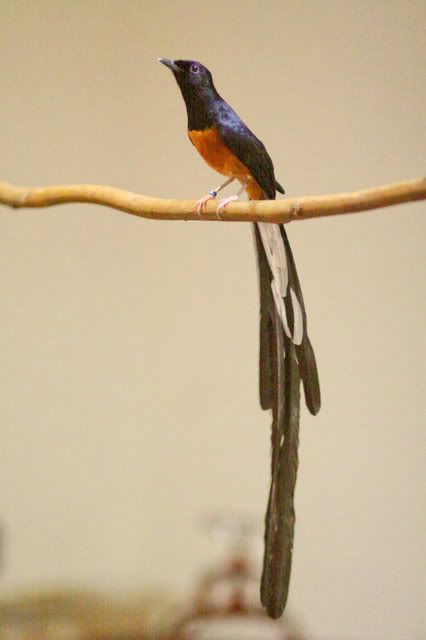Murai Batu (White Rumped Shama/ C. Malabaricus)
Source: David's collection
CLASSIFICATION
Phylum / Division Chordata
Class Aves
Order Passeriformes
Family Muscipidae
C. species malabaricus
Zoological name Copsychus malabaricus
Physical characteristics: Murai Batu (White Rumped Shama) is one of the birds sing a pretty famous for its sonority of his voice. Medium size, approximately 27 cm and weighs about 32 grams. Thin black beak and head size of an average round (although there are some who shaped a bit flat & slightly thicker). Tail length 15-35 cm (depending on species). Tail consists of four strands of black primer and eight strands of the secondary tail is white (there are certain species of black all). In total there are 12 pieces of tail. Individual males sparkling indigo, jet black in color with the color orange chest in general, (there are some maroon colored) were female individual color is slightly paler than the male plumage. Part butt under the tail is white. Female individual body size is slightly smaller than male individuals.
Habitat: Murai Batu usually live in dense jungle and the jungle lowlands to 1500 m fringed meeting.
Food in nature: small invertebrates and insects. Generally, they eat insects such as grasshoppers, crickets, tenacious, worms, small fish, and fruit of certain species.
Reproduction: Incubation for 12-15 days. Individual males are generally more aggressive. Every day of laying as many as one item. The number of eggs can reach six points. Color white eggs with reddish brown spots. At hatch, the baby bird (piyik) has not been able to open my eyes. New approximately six days after the eye has been able to open. The feathers they develop within 11 days.
Conservation status: Still less attention even though its population is estimated to have decreased. Along with the lack of jungle habitat that supports them.
Age: Murai stones can reach 10-15 years of age.
Regional distribution: Philippines, Indonesia, Malaysia, Cambodia, Thailand, Vietnam, Myanmar, China and India.
CLASSIFICATION
Phylum / Division Chordata
Class Aves
Order Passeriformes
Family Muscipidae
C. species malabaricus
Zoological name Copsychus malabaricus
Physical characteristics: Murai Batu (White Rumped Shama) is one of the birds sing a pretty famous for its sonority of his voice. Medium size, approximately 27 cm and weighs about 32 grams. Thin black beak and head size of an average round (although there are some who shaped a bit flat & slightly thicker). Tail length 15-35 cm (depending on species). Tail consists of four strands of black primer and eight strands of the secondary tail is white (there are certain species of black all). In total there are 12 pieces of tail. Individual males sparkling indigo, jet black in color with the color orange chest in general, (there are some maroon colored) were female individual color is slightly paler than the male plumage. Part butt under the tail is white. Female individual body size is slightly smaller than male individuals.
Habitat: Murai Batu usually live in dense jungle and the jungle lowlands to 1500 m fringed meeting.
Food in nature: small invertebrates and insects. Generally, they eat insects such as grasshoppers, crickets, tenacious, worms, small fish, and fruit of certain species.
Reproduction: Incubation for 12-15 days. Individual males are generally more aggressive. Every day of laying as many as one item. The number of eggs can reach six points. Color white eggs with reddish brown spots. At hatch, the baby bird (piyik) has not been able to open my eyes. New approximately six days after the eye has been able to open. The feathers they develop within 11 days.
Conservation status: Still less attention even though its population is estimated to have decreased. Along with the lack of jungle habitat that supports them.
Age: Murai stones can reach 10-15 years of age.
Regional distribution: Philippines, Indonesia, Malaysia, Cambodia, Thailand, Vietnam, Myanmar, China and India.

No comments:
Post a Comment